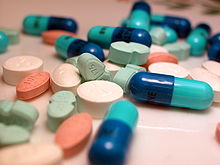Medication
[1][2] Drug therapy (pharmacotherapy) is an important part of the medical field and relies on the science of pharmacology for continual advancement and on pharmacy for appropriate management.As a result of this complex path from discovery to commercialization, partnering has become a standard practice for advancing drug candidates through development pipelines.[3] As defined by the National Cancer Institute, dosage forms of medication can include tablets, capsules, liquids, creams, and patches.[9] Drugs affecting the central nervous system include psychedelics, hypnotics, anaesthetics, antipsychotics, eugeroics, antidepressants (including tricyclic antidepressants, monoamine oxidase inhibitors, lithium salts, and selective serotonin reuptake inhibitors (SSRIs)), antiemetics, anticonvulsants/antiepileptics, anxiolytics, barbiturates, movement disorder (e.g., Parkinson's disease) drugs, nootropics, stimulants (including amphetamines), benzodiazepines, cyclopyrrolones, dopamine antagonists, antihistamines, cholinergics, anticholinergics, emetics, cannabinoids, and 5-HT (serotonin) antagonists.Bronchodilators, antitussives, mucolytics, decongestants, inhaled and systemic corticosteroids, beta2-adrenergic agonists, anticholinergics, mast cell stabilizers, leukotriene antagonists.Antifungal, alkalinizing agents, quinolones, antibiotics, cholinergics, anticholinergics, antispasmodics, 5-alpha reductase inhibitor, selective alpha-1 blockers, sildenafils, fertility medications.Emollients, anti-pruritics, antifungals, antiseptics, scabicides, pediculicides, tar products, vitamin A derivatives, vitamin D analogues, keratolytics, abrasives, systemic antibiotics, topical antibiotics, hormones, desloughing agents, exudate absorbents, fibrinolytics, proteolytics, sunscreens, antiperspirants, corticosteroids, immune modulators.Antibiotics, antifungals, antileprotics, antituberculous drugs, antimalarials, anthelmintics, amoebicides, antivirals, antiprotozoals, probiotics, prebiotics, antitoxins, and antivenoms.There are three major categories of drug administration: enteral (via the human gastrointestinal tract), injection into the body, and by other routes (dermal, nasal, ophthalmic, otologic, and urogenital).[citation needed] Historically, drugs were discovered by identifying the active ingredient from traditional remedies or by serendipitous discovery.Later chemical libraries of synthetic small molecules, natural products, or extracts were screened in intact cells or whole organisms to identify substances that have a desirable therapeutic effect in a process known as classical pharmacology.In its broad definition, this encompasses all steps from the basic research process of finding a suitable molecular target to supporting the drug's commercial launch.Despite the enormous advances in science and technology, the number of new blockbuster drugs approved by the government per billion dollars spent has halved every 9 years since 1950.[26] In the pharmaceutical industry, a blockbuster drug is one that achieves acceptance by prescribing physicians as a therapeutic standard for, most commonly, a highly prevalent chronic (rather than acute) condition.Penicillin, introduced a few years later, provided a broader spectrum of activity compared to sulfa drugs and reduced side effects.[citation needed] Lithium was discovered in the 19th century for nervous disorders and its possible mood-stabilizing or prophylactic effect; it was cheap and easily produced.Doctors prescribe estrogen for their older female patients both to treat short-term menopausal symptoms and to prevent long-term diseases.The popularity of meprobamate paved the way for Librium and Valium, two minor tranquilizers that belonged to a new chemical class of drugs called the benzodiazepines.The 1991 launch of Pravachol (pravastatin), the second available in the United States, and the release of Zocor (simvastatin) made Mevacor no longer the only statin on the market.[34] The earliest foundations of ayurveda were built on a synthesis of selected ancient herbal practices, together with a massive addition of theoretical conceptualizations, new nosologies and new therapies dating from about 400 BC onwards.[36] The pharmacopoeia De materia medica, written between 50 and 70 CE by the Greek physician Pedanius Dioscorides, was widely read for more than 1,500 years.Theodoric Borgognoni, (1205–1296), one of the most significant surgeons of the medieval period, responsible for introducing and promoting important surgical advances including basic antiseptic practice and the use of anaesthetics.[vague] For most of the 19th century, drugs were not highly effective, leading Oliver Wendell Holmes Sr. to famously comment in 1842 that "if all medicines in the world were thrown into the sea, it would be all the better for mankind and all the worse for the fishes".Medicines commonly used by the late 1920s included aspirin, codeine, and morphine for pain; digitalis, nitroglycerin, and quinine for heart disorders, and insulin for diabetes.[27]: 22 In the 1950s, other drugs emerged including corticosteroids for inflammation, rauvolfia alkaloids as tranquilizers and antihypertensives, antihistamines for nasal allergies, xanthines for asthma, and typical antipsychotics for psychosis.Governments worldwide have created provisions for granting access to drugs prior to approval for patients who have exhausted all alternative treatment options and do not match clinical trial entry criteria.[citation needed] World Trade Organization negotiations in the 1990s, including the TRIPS Agreement and the Doha Declaration, have centered on issues at the intersection of international trade in pharmaceuticals and intellectual property rights, with developed world nations seeking strong intellectual property rights to protect investments made to develop new drugs, and developing world nations seeking to promote their generic pharmaceuticals industries and their ability to make medicine available to their people via compulsory licenses.Some have raised ethical objections specifically with respect to pharmaceutical patents and the high prices for drugs that they enable their proprietors to charge, which poor people around the world, cannot afford.[47][48] Critics also question the rationale that exclusive patent rights and the resulting high prices are required for pharmaceutical companies to recoup the large investments needed for research and development.[51] Pharmaceutical medications are commonly described as "ubiquitous" in nearly every type of environmental medium (i.e. lakes, rivers, streams, estuaries, seawater, and soil) worldwide.

Pharmacypharmacologypharmaceutical industrymedication (disambiguation)meds (disambiguation)medicine (disambiguation)prescription drugdiagnosepreventpharmacotherapymedical fieldclassifiedcontrolprescription drugsmedical prescriptionover-the-counter drugsroute of administrationbiological systemtherapeutic effectsWorld Health Organizationessential medicinesDrug discoverydrug developmentpharmaceutical companieshow drugs are marketeddrug pricingchemical compoundEncyclopædia BritannicaNational Cancer Institutedosage formstabletscapsulescreamsby mouthinfusion into a veindrops put into the earactive ingredientplacebopharmacologicalimmunologicalmedical diagnosisdiagnosisprevention of diseasepharmacopeiaformularyover-the-counterdietary supplementDrug classsmall moleculebiological medical productsrecombinant proteinsvaccinesblood productsgene therapycell therapystem cellchemical propertiesclassification systemAnatomical Therapeutic Chemical Classification SystemAntipyreticsAnalgesicsAntimalarial drugsmalariaAntibioticsAntisepticswoundsMood stabilizerslithiumvalproateHormone replacementsPremarinOral contraceptivesStimulantsmethylphenidateamphetamineTranquilizersmeprobamatechlorpromazinereserpinechlordiazepoxidediazepamalprazolamStatinslovastatinpravastatinsimvastatinlaxativesantispasmodicsantidiarrhoealsbile acid sequestrantsopioidsdigestive tractantacidsreflux suppressantsantiflatulentsantidopaminergicsproton pump inhibitorsH2-receptor antagonistscytoprotectantsprostaglandin analoguesblood pressureantihypertensive drugsACE inhibitorsangiotensin receptor blockersbeta-blockersα blockerscalcium channel blockersCoagulationanticoagulantsheparinantiplatelet drugsfibrinolyticsanti-hemophilic factorshaemostatic drugsβ-receptor blockersdiureticscardiac glycosidesantiarrhythmicsnitrateantianginalsvasoconstrictorsvasodilatorsHMG-CoA reductase inhibitorshypolipidaemic agentscentral nervous systempsychedelics